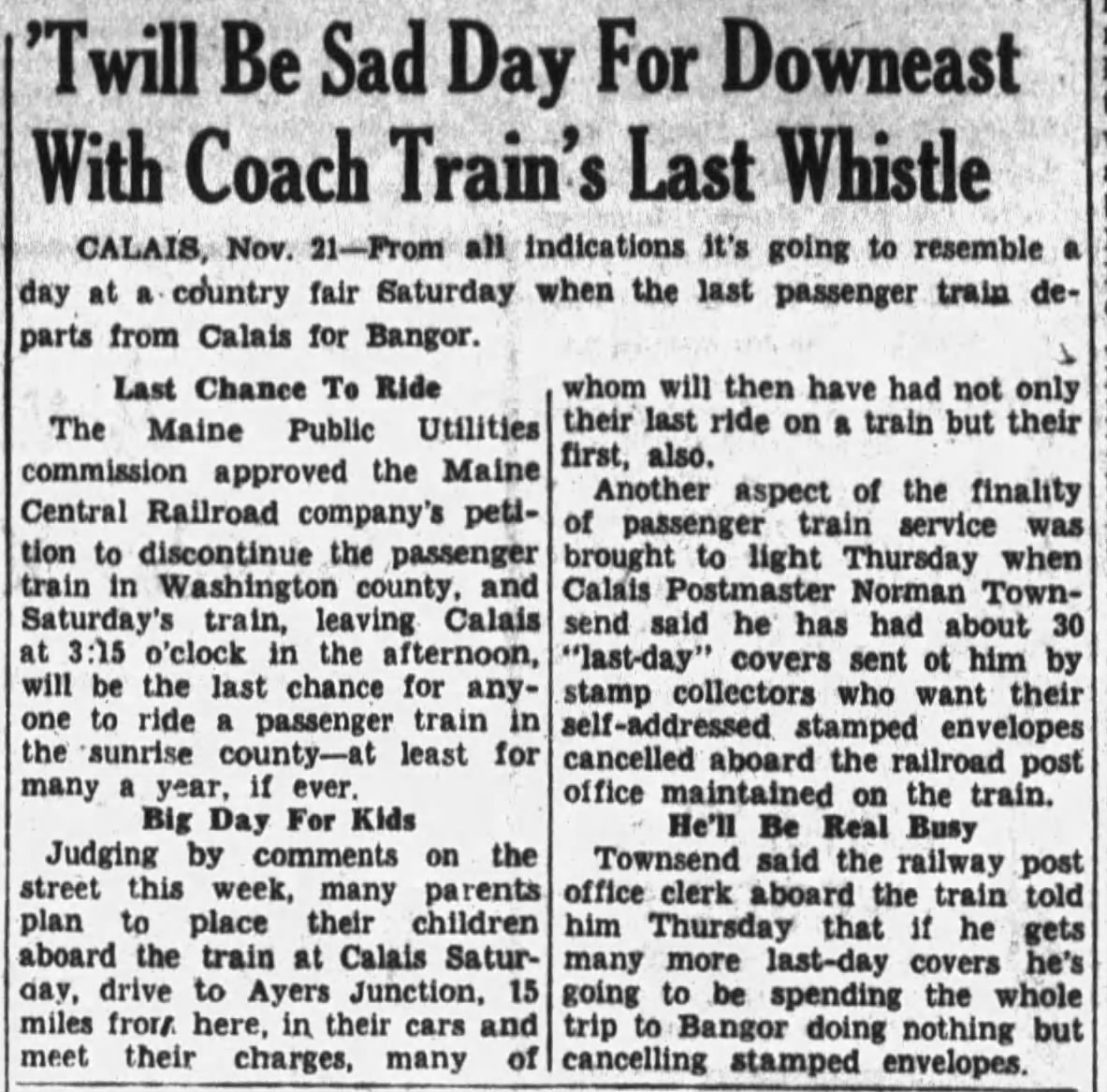
November 22, 1957, BDN
Twill Be Sad Day For Downcast With Coach Train’s Last Whistle
CALAIS Nov 21
From all Indications it’s going to resemble a day at a country fair Saturday when the last passenger train departs from Calais for Bangor
Last Chance To Ride
The Maine Public Utilities commission approved the Maine Central Railroad companies petition to discontinue the passenger train in Washington County, and Saturday’s train, leaving Calais at 3:15 o’clock in the afternoon, will be the last chance for anyone to ride a passenger train in the sunrise county- at least for many a year, if ever.
Big day for kids
Judging by comments on the street this week many parents plan to place their children aboard the train at Calais Saturday, drive to Ayers junction, 15 miles from here, in their cars and meet their charges, many of whom would then have had not only their last ride on a train but their first also.
Another aspect of the finality of passenger train service was brought to light Thursday when Calais postmaster Norman Townsend said he has had about 30 “last day” covers sent to him by stamp collectors who want their self-addressed stamped envelopes cancelled aboard the railroad post office maintained on the train.
He’ll be real busy.
Townsend said the railway post office clerk aboard the train told him Thursday that if he gets many more “last day” covers he’s going to be spending the whole trip to Bangor doing nothing but cancelling stamped envelopes.
November 23rd, 1957 was indeed the end of an era Downeast. Calais had one of the first railroads, if not the first, in the State. Built in 1837, the tracks and ties were wooden, and the horses pulled the cars laden with milled lumber on the wooden rails along the path by the river which is today the waterfront walkway. It was a short-lived affair as neither the horses nor rails could withstand the weight of large loads of freshly milled lumber and the $35,000 enterprise went bust in just a few years.
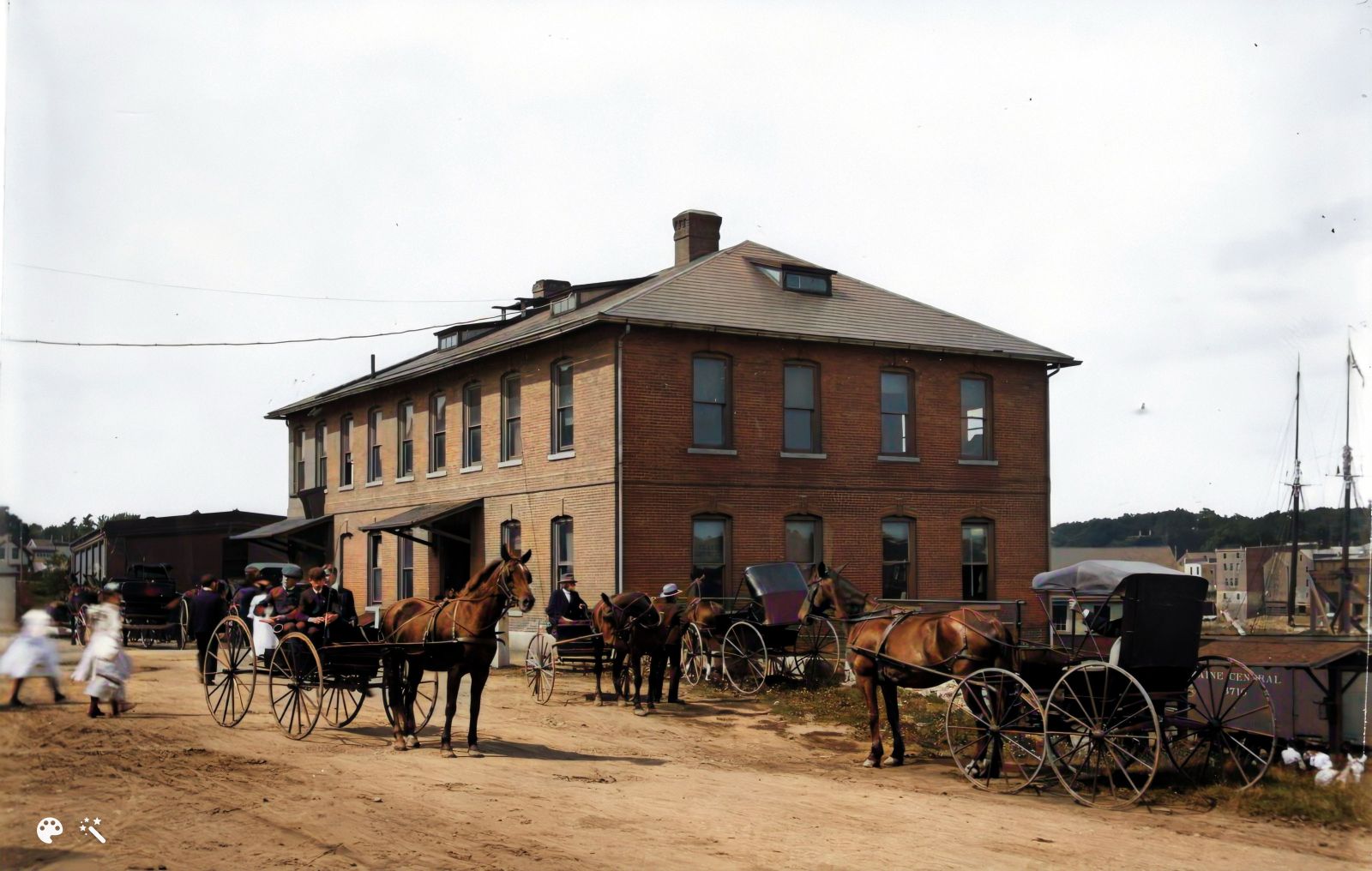
Calais Train Station about 1900
It was not until 1898 that Calais was connected by rail with the rest of the country-probably the last major Maine city to be connected. Until 1898 Downeasters had to travel to Vanceboro or on the other end of the county to Ellsworth to connect with the Bangor/Boston train. Sadly for train travel Downeast the first automobiles began appearing on the streets of Calais within 5 years and the march of what was then considered progress was to eventually spell doom for the passenger train although it took several decades.
The top speed on the Calais to Bangor line was 40 miles an hour—although it almost never managed to go that fast. The cost of tickets was 3-4 cents a mile. In 1951 when railroad passenger service had become a victim of the automobile, Maine Central was offering a special two cent a mile rate “between any two Maine Central stations in the State of Maine. It did little good- the last passenger train left the Calais station for Bangor on November 23, 1957.
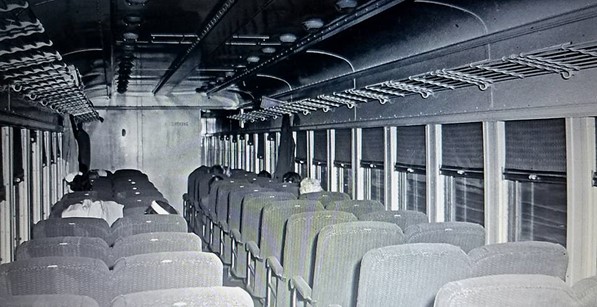
Maine Central-Interior of Passenger Car
The seats in the passenger cars were fairly large by today’s standards, about the same size as seats on today’s buses, far roomier than airline seats, and people were generally smaller back then. There may have been club cars on the longer routes but probably not on the Calais to Bangor run and for those impatient today when stopped for construction, the train made 22 stops between Calais and Bangor including at stations in Brewer Junction, Ellsworth Falls, Green Lake, Ellsworth, Tunk Pond, Unionville, Cherryfield, Columbia Falls, Jonesboro, East Machias, Machias, Machiasport, Ayers Junction and Calais. At Ayers Junction a spur line ran to Pleasant Point and Eastport.
Lyman Holmes, our train expert, provides this summary of the situation in the early 1950’s.
In 1953 Calais was served by an eastbound passenger train that left Bangor at 5:10 a.m. and arrived at Calais at 10:00 a.m. The westbound train left Calais at 4:55 p.m. and arrived at Bangor at 9:45 p.m.
Unfortunately, I do not have the Calais – Bangor fare at hand. However, the Calais – Portland fare was $10.48 one way and $18.63 round trip. The Portland – Bangor fare was $5.35 one way so I imagine from that that the Calais – Bangor fare must have been around $5-6.
At this time the eastbound Bangor to Calais train carried a Pullman sleeping car on Mondays, Wednesdays and Fridays which had left Boston the night before. The westbound Calais to Bangor train carried this sleeping car on the return trips leaving Calais on Mondays, Wednesdays and Fridays. Earlier in the 1950s the sleeping car was operated six days a week, but the sleeping car service had been cut back to three days a week by Sept. 1953. For most of its history Calais – Bangor passenger trains operated six days a week and did not operate on Sundays.
For many years, the Calais branch had four passenger trains a day (except Sundays) as follows:
A morning eastbound passenger train from Bangor to Calais
A morning westbound passenger train from Calais to Bangor
An afternoon/evening eastbound passenger train from Bangor to Calais
An afternoon/evening westbound passenger train from Calais to Bangor.
The morning westbound passenger train and the afternoon/evening eastbound train were discontinued on July 6, 1953. Ross Haycock was the long-time conductor on these trains and I believe he retired after the final run to Calais.
The three-day-a-week Boston – Bangor- Calais Pullman sleeping car was discontinued in Sept. 1955.
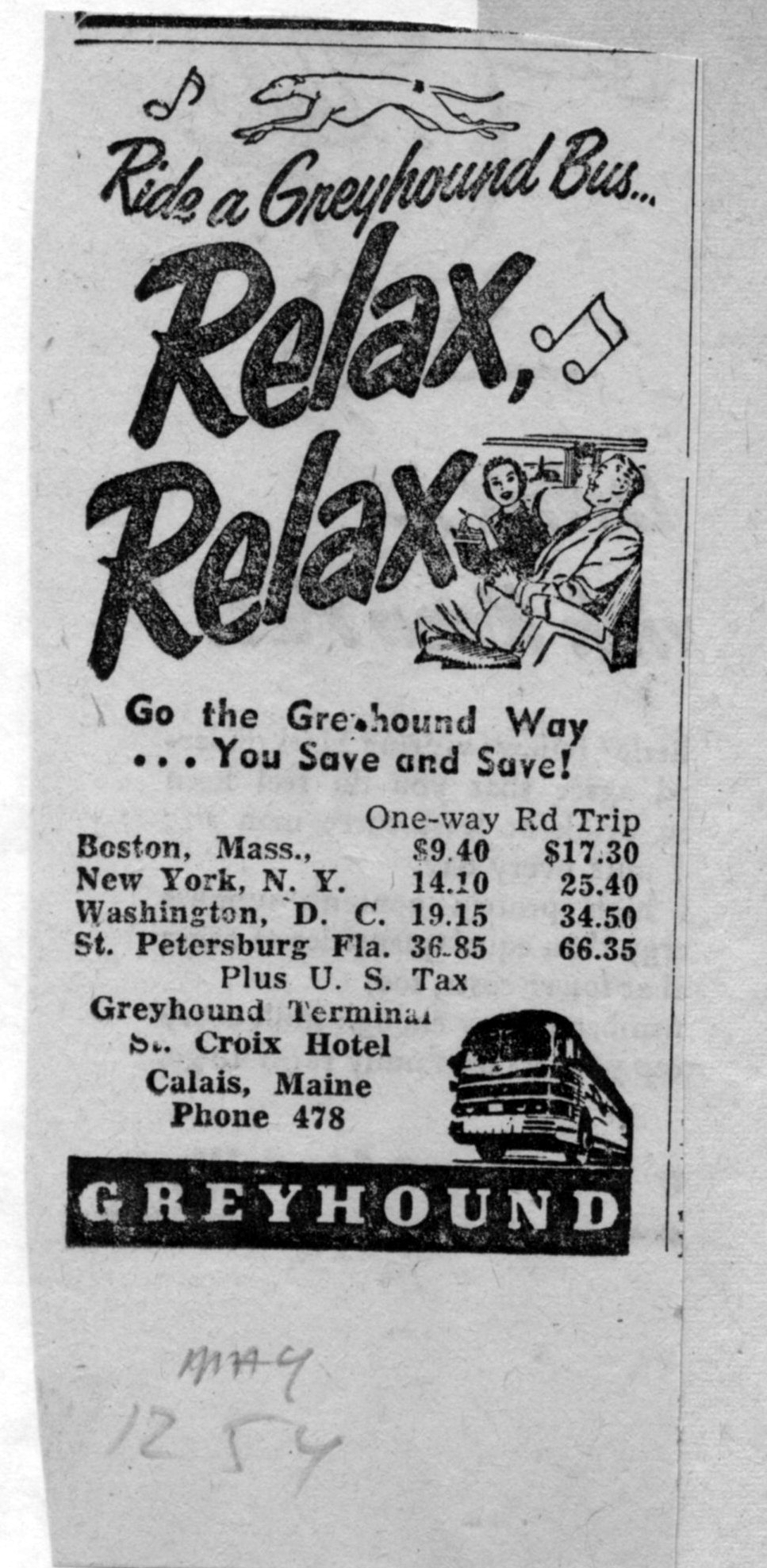
By 1954 several Greyhound buses were stopping at the St. Croix Hotel daily
By the early 1950’s the roads were passable for much of the year although the Airline remained an adventure for another decade. Greyhound was running buses Downeast several times a day through to the Maritimes. They all stopped at the St. Croix Hotel. While the seats were cramped and they didn’t have toilets, buses were convenient and had fares comparable to the train. By the summer of 1957 the lack of a future for Downeast rail passenger service was clear. Many people, especially children, had never ridden the train.
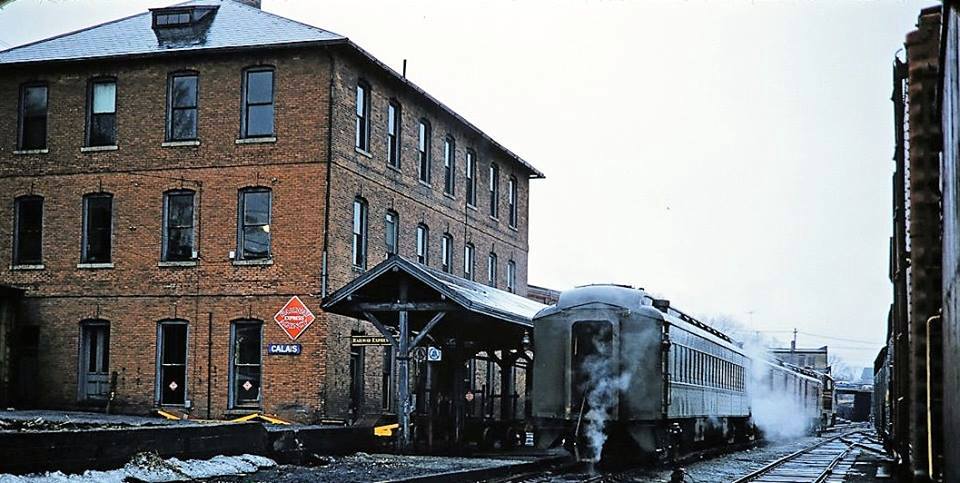
A passenger train at Calais railroad station
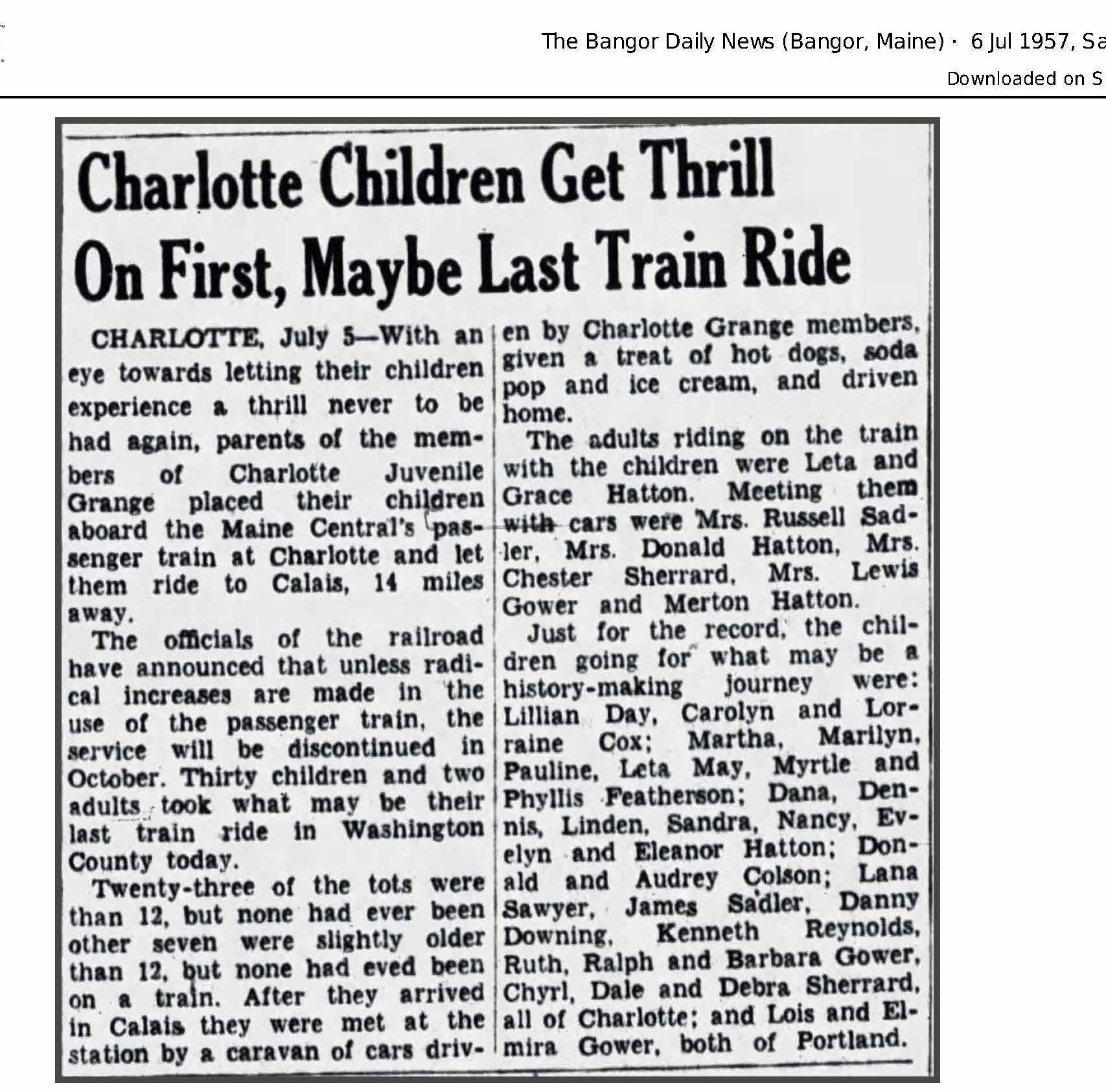
Charlotte Children Get Thrill On First Maybe Last Train Ride
CHARLOTTE July 5-With an eye towards letting their children hot dogs’ experience a thrill never to be had again, parents of the members of Charlotte Juvenile Grange placed their children aboard the Maine Central’s passenger train at Charlotte and let them ride to Calais 14 miles away.
The officials of the railroad have announced that unless radical increases are made in the use of the passenger train, the service will be disconnected in October period 30 children and two adults took what may be their last train ride in Washington County today.
23 of the tots were then 12, but none had ever been on a train. After they arrived in Calais they were met at the station by a caravan of cars driven by Charlotte range members, given a treat of hot dogs, soda pop and ice cream, and driven home.
The adults riding on the train with the children were Leta and Grace Hatton. Meeting them in cars were Russell Sadler, Donald Hatton, Mrs. Chester Sherrard, Mrs. Lewis Gower and Merton Hatton.
Just for the record the children going for what may be a history making journey were: Lillian Day, Carolyn and Lorraine Cox, Martha, Marilyn, Pauline, Leta May, Myrtle and Phyllis Featherson; Dennis, Lyndon, Sandra, Nancy, Evelyn and Eleanor Hatton; Donald and Audrey Colson; Lana Sawyer, James Sadler, Danny Downing, Kenneth Reynold;, Ruth, Ralph and Barbara Gower, Cheryl, Dale and Deborah Sherrard, all of Charlotte and Lois and Elmira Gower, both of Portland Maine.
The last Downeast passenger train ran on November 23rd, 1957. The trip is described in the Bangor Daily News the following day.
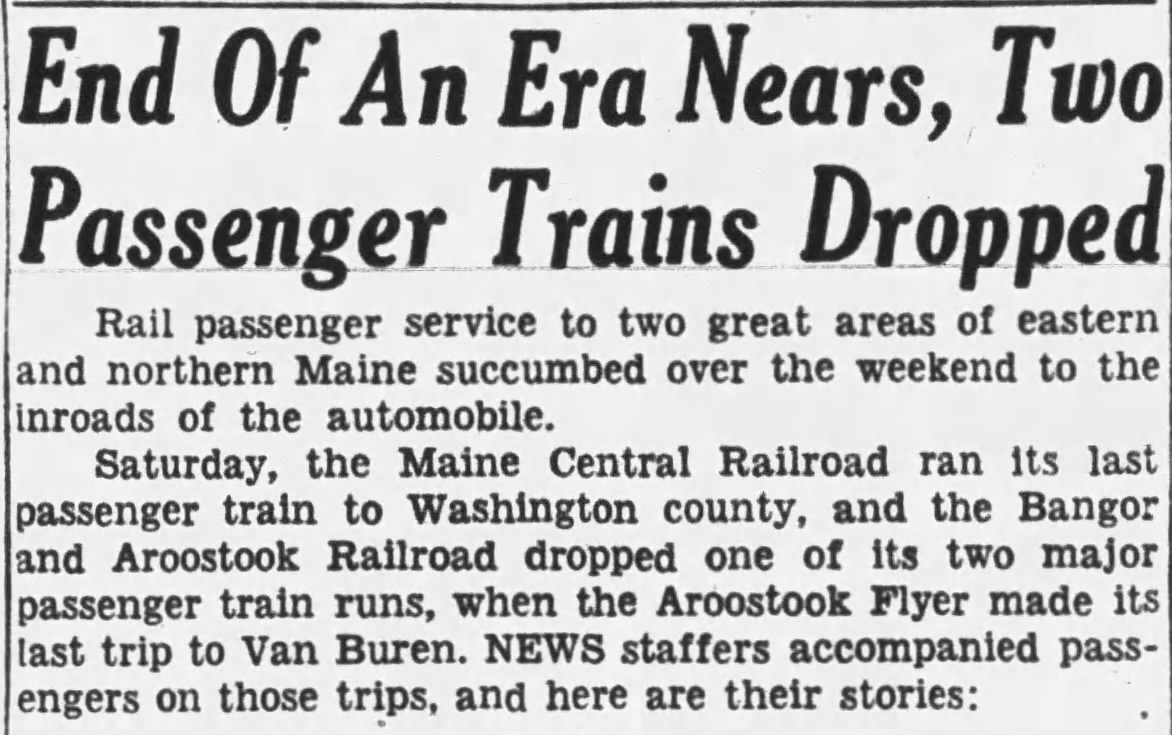
BY JEANNE PURCELL
It takes but a day for a reality to become a legend. At 6:10 o’clock Saturday morning train No 123 the Maine Calais to Bangor branch line passenger train pulled out of Union Station Bangor to make its final trip Down East terminating all rail passenger service in Washington County.
Lights filtered into the waning darkness as the train with two coaches, two baggage cars and 12 persons aboard started its last journey The inception of the present Maine Central system started in 1832 when the Calais Railway Company received a charter from the legislature to build a two-mile stretch of railroad between Calais and Milltown. Freight cars loaded with lumber were hauled by horses from the mills to the wharves.
Incorporated In 1893
The Washington County Railway was incorporated in 1893 and built a branch line to connect Maine Central in Hancock County with another spur to Eastport. The first through passenger train from Calais and Eastport to Washington Junction made its initial excursion Thursday December 29, 1898. The last through passenger train ran Saturday November 23rd.
The Maine Central acquired control in 1904, the property was merged in 1911 and through the years the citizens of Washington County have been served daily except Sundays by the Bangor-Calais train. Of late the number of persons taking advantage of the service has been steadily declining until the railroad found itself in a position where it became necessary to ask for discontinuance of the line. In the summer of 1957, the railroad conducted a test period and added an air-conditioned coach to increase patronage, but traffic still decreased. October 23 the Maine Public Utilities Commission granted permission to discontinue service.
Saturday’s trip provided the gamut of emotions from a slow beginning working to a climax and ending quietly and finally back in Bangor.
Made First Trip
Among the passengers was an 84-year-old man from Portland who made the trip for the sole purpose of riding the last train. Daniel Shaw was a passenger on the first trip of the Washington County Railway from Calais to Washington Junction in 1898. Shaw a retired employee of the New England Telephone and Telegraph Company helped install the telegraph lines along the road before it was completed He recalls the hardships of working 14 hours a day In the woods for $1.75 a day One night he and his crew of 10 men walked four miles through six Inches of snow to their boarding cars at Franklin where they found the engine that was supposed to pick them up derailed.
His memory of the first trip is overshadowed by a near tragedy that occurred at Unionville. The newsboy, who thought the train was stopping, started to jump off. Realizing the locomotive was just slowing down he attempted to get back into the baggage car, slipped and fell beneath the train wheels. He lost both legs in the accident, but recovered and was the new news agent at Calais for a good many years.
A Franklin man said that he was a small boy when the railroad was being constructed and he carried water for the workers. He said the biggest thrill of his life was riding in the caboose of the train that shuttled between Washington Junction and Schoodic Bog filling in the roadbed with gravel.
Romance Lives
Remember the days when you asked a young boy what he wanted to be when he grew up and he answered a trained engineer? Apparently, the romance of the train ride hasn’t completely faded from the minds of the youngsters. The train wended its way down through Washington Junction Franklin, Cherryfield, Columbia Falls and arrived at Machias where a group of over 30 youngsters scrambled aboard with the assorted parents and friends. The coach assumed the homeliness of a country store accompanied by the din of clamoring children. They waved goodbye to the platform standees with their faces jammed up against the windows. One youngster, about four years old, propped on his father’s arm exclaimed “What’s This?”
Over 100 youngsters aboard
Over 100 youngsters, many having their first, and perhaps last train ride, rode some part of the way to Calais. On through Dennysville Junction, Milltown and Calais the kids rode the rails, spending much of their time in the aisles or at the water cooler.
During the four-and-a-half-hour layover in Calais excitement seemed to generate through the citizens, and long before the train time crowds began to gather. The line at the ticket window was long and a festive mood seemed to permeate the air.
As 3:25 o’clock approached people were still shaking hands with the crew members: Everett L. McKay of Bangor, and engineer; William J Cobb, Bangor, conductor; John McKay McIver, Bangor trainman; Phillip Boudreaux, Bangor, baggage master; Lloyd Ashford, Winterport, fireman; and Bert Pullen, the Calais agent and W.C. Hanson of Calais, car inspector.
When “all aboard” was shouted, 98 children and parents were on the train and people flooded the platform to wave farewell.
The two coaches were crowded with excited children all pointing out familiar landmarks to each other. The train eased along up the Saint Croix River looking over into Saint Stephen, NB, past Pennamaquan Lake and Round Pond with a small caravan of cars following. One woman said it reminded her of the Sunday school picnics she used to participate in. Children were munching popcorn and candy, and all tried to look out the same window and one little boy got caught between two seats and had to be extricated by the conductor. It was almost an atmosphere of celebration with the parents getting as much of a thrill out of the journey as the children.
Most of the Calais people were going as far as Ayers Junction, where 77 voyagers departed leaving behind three or four hats and several pairs of mittens. About 25 automobiles were waiting with more arriving to take the adventurers back to Calais. As train #116 pulled out of the junction the motorists all paid a final salute with a long blast of car horns. Conductor Cobb said these kids – they are wonderful. I got a real thrill out of this trip, and you can’t beat these Washington County people.
In the mail car the clerk was busy stamping over 100 last day covers that had been sent in from stamp collectors all over New England and by railroad clerks throughout the country.
All the railroad stations along the route are for sale, with some already disposed of. The Columbia Falls station was sold to the Washington County arts and crafts association; the Machias station will be converted into offices; and a wholesale grocery firm has purchased the Calais Roundhouse for use as a warehouse.
The train with its four remaining passengers arrived in Union Station, its final journey concluded. Conductor Cobb spoke for all when he said, the end of a perfect day.
But there will be no tomorrow.
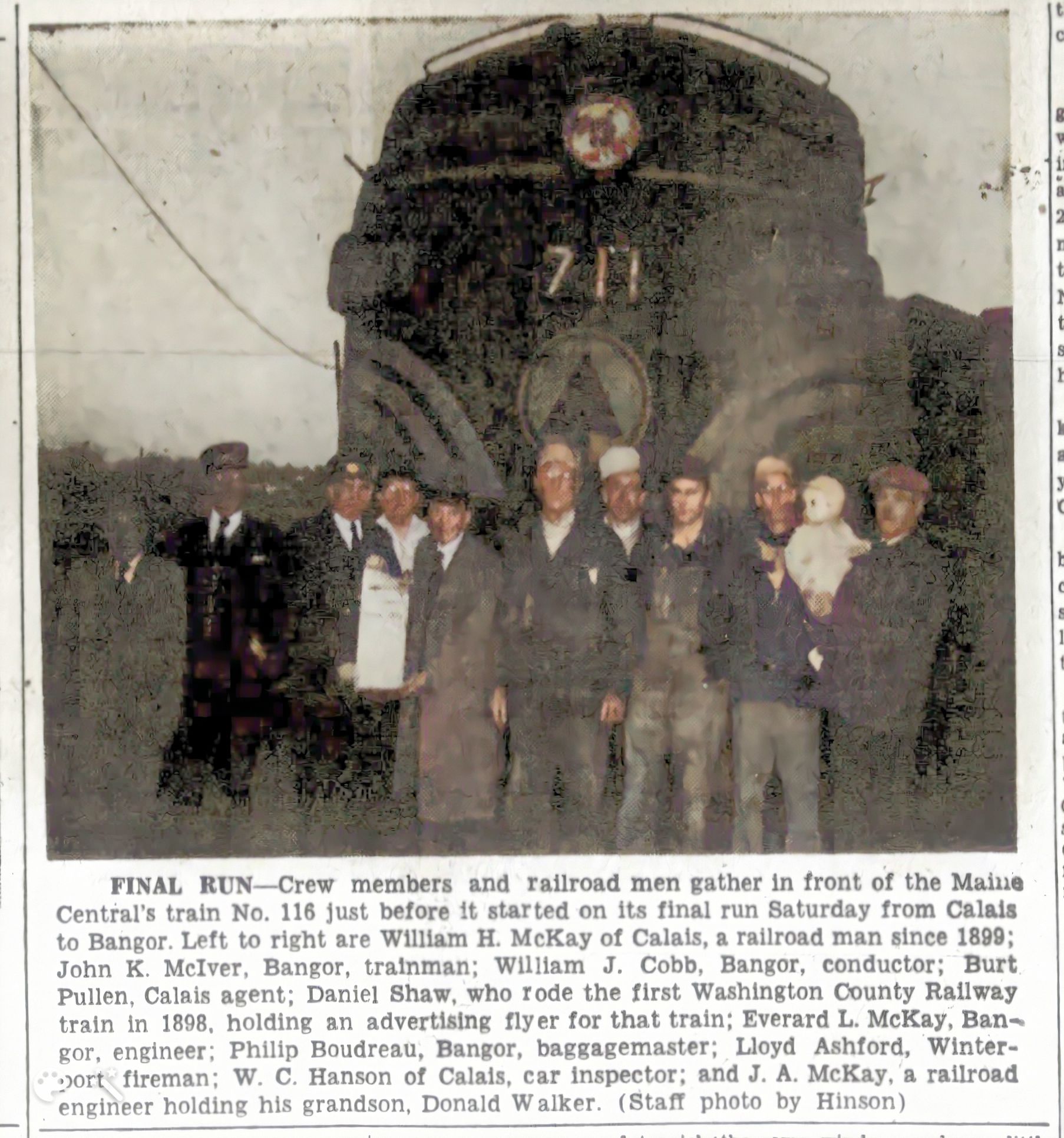
FINAL RUN— Crew members and railroad men gather in front of the Main Central’s train No 116 Just before it started on its final run Saturday from Calais to Bangor. Left to right are William H McKay of Calais a railroad man since 1899, John K Mclver Bangor trainman William J. Cobb, Bangor conductor; Burt Pullen, Calais agent; Daniel Shaw, who rode the first Washington County Railway train in 1898 holding an advertising flyer for that train; Everard L. McKay, Bangor engineer; Philip Boudreau, Bangor baggage master; Lloyd Ashford, Winterport fireman; W. C. Hanson of Calais, car inspector and J. A. McKay, a railroad engineer holding his grandson Donald Walker (Staff photo by Hinson)
Note the photo was taken by Jay Hinson, then the Bangor Daily correspondent Downeast.
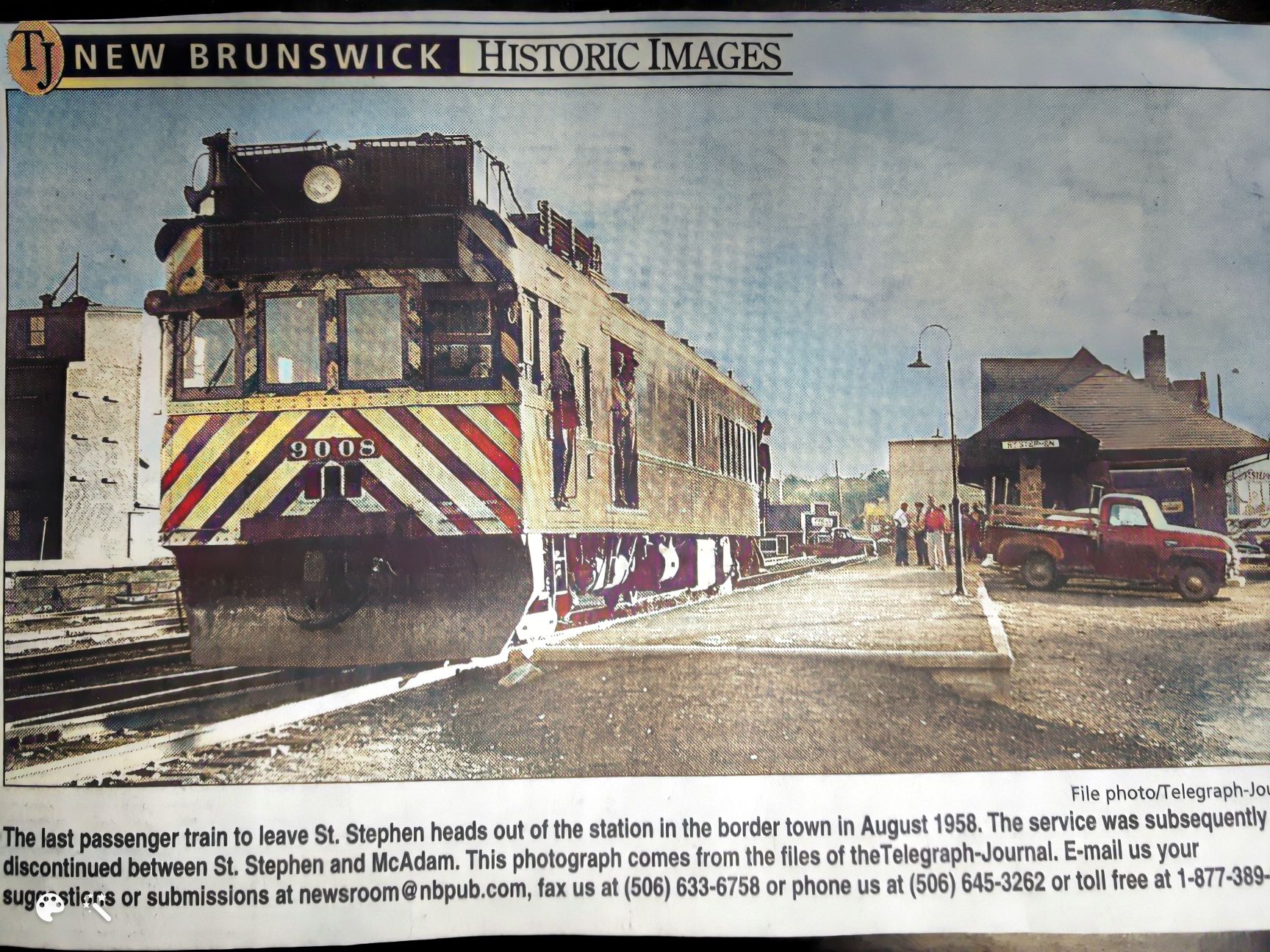
Passenger service ends in St. Stephen, August 1958
The folks in St. Stephen continued to have passenger service but only for a few months. It was the end of an era on both sides of the border although freight service continued for a couple of decades and many will recall the jarring metallic clanking emanating from the railyard into the 1980s when the trains were coupling with the boxcars.
